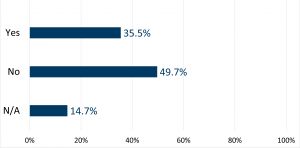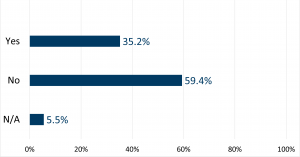- Home
- / Working During the Pandemic Survey Results
Working During the Pandemic Survey Results
During mid-December 2020, AESES invited members from the University of Manitoba (UM) and The University of Winnipeg (UW) to complete a short, anonymous survey about their working conditions during the pandemic. Below are some highlights from the survey responses specific to each University.
During mid-December 2020, AESES invited members from the University of Manitoba (UM) to complete a short, anonymous survey about working conditions during the pandemic.
Thank you to the 970 members who responded honestly and openly about their struggles, concerns and unexpected triumphs. Although we had varied responses, most participants echoed that they were all struggling with the same problems. While members are not alone in their common experiences, it is apparent that many are feeling the effects of being isolated during the pandemic.
AESES will present the University’s administration with the larger concerns that have been identified in the survey. It is our intent to illustrate to the University the difficulties our members are facing and advocate on your behalf for better support and direction. This would include pointing out the many positive changes that have been adopted and our members’ desires to continue them post-pandemic. Here are some highlights from the survey responses.
Members working from home
70.5% of respondents said they were working from home. 37.6% have seen an increase in workload due to many factors, including the time it takes to get things done remotely. Of the members working from home, 42.5% have had their regular work break routines disrupted, stating they are just too busy (due to understaffing, deadlines, and pressure from supervisors) or forget to take breaks (lose track of time or no cues from co-workers).
When asked about overtime, 37.0% said they are working longer hours and not reporting it. The causes were to keep up with the increased workload, after-hours emails from supervisors or did not realize they are working later after finding a flow that worked for them. Many comments included that supervisors did not know what members do and how long it takes to complete tasks or duties. 20.2% said their supervisor does not have a good understanding of their workload.
45.0% said that they had not claimed sick days but, in turn, just worked through it while working remotely. 35.5% of members had problems working from home, including ergonomic issues, internet connectivity or technology problems (VPN, account access, hardware issues). Lack of physical supplies, files and access to printers was also problematic for members.
The responses showed that many members had family distractions, and the overuse and overscheduling of virtual meetings negatively impact the workday.
Members working onsite
For our members who are working onsite, 17.2%, have seen an increase in their workload. 18.4% of members had disrupted work break routines due to being short-staffed, too busy, no safe break location or no co-workers around. 14.1% were working overtime and not reporting it to keep up with increased workload demands.
10.7% of members reported that health and safety was a concern for them. They were worried about working alone and the security implications that might have. Noted was the lack of and improper use of personal protective equipment, and no one monitoring adherence to policies. Members were worried about exposure risks due to a lack of distance/space between co-workers, and especially during their commute on public transit to work. Several members were also not confident in the cleaning procedures being followed for some campus locations.
All members
Overall wellness is a top priority for our members during and outside of working hours. If you need to talk, please reach out to your family physician, the Employee & Family Assistance Program (EFAP) or visit the AESES Wellness Resources page for more information.
Almost half of the respondents did notice an increase in being anxious (43.8%), frustrated (45.5%) and had trouble sleeping (42.1%). On the flip side, 46.3% reported that they were managing the situation well.
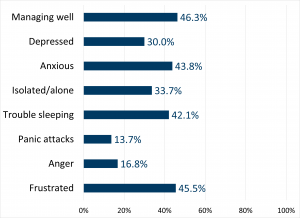
#21 | From a mental health perspective, please indicate your state of wellness since the onset of the pandemic (choose all that apply).
Our respondents also indicated experiencing other negative effects such as difficulty concentrating, increased headaches, irritability, overwhelmed, overall fatigue, and problems managing childcare (school closures, daycare) and children learning from home (22.8%).
On the positive side, several members were happy and love the current situation, and are thriving. They said their mental health has improved because of increased sleep (no commute), enhanced productivity, and the removal from a toxic work environment.
19.1% of members have not taken any vacation days since March 2020. Reasons for this included that current staffing levels and workload prohibited it. 43.9% (as of early January) still have more than 11 vacation days available. 18.7% anticipate concerns taking vacation days above the carry over limit by March 31, 2021.
AESES encourages members to take their allocated vacation days from work to recharge and forget about work for a while. Even if you only unplug from the VPN and spend time with your family, pets or binge a television series.
12.4% of members said they were taking on work of temporarily laid-off employees, and 7.2% said it was interfering in the ability to get their job done.
Conclusion
With over seventy percent of AESES-UM members working remotely, 60.2% would want this to continue after the pandemic, and 23.6% said no. While some members had concerns about returning to campus too soon, most members stated they wanted a combination of remote and on-campus work options once the UM returns to normal operations. A few benefits mentioned were the ability to work through sick days, terrible road/weather conditions, at home with a sick child, better mental health and work/life balance, and free up much-needed campus office space.

#36 | If you’ve been working remotely since the start of the pandemic, would you prefer to continue working from home when the University resumes normal operations?
During mid-December 2020, AESES invited members from The University of Winnipeg (UW) to complete a short, anonymous survey about working conditions during the pandemic.
Thank you to the 191 members who responded honestly and openly about their struggles, concerns and unexpected triumphs. Although we had varied responses, most participants echoed that they were all struggling with the same problems. While members are not alone in their common experiences, it is apparent that many are feeling the effects of being isolated during the pandemic.
AESES will present the University’s administration with the larger concerns that have been identified in the survey. It is our intent to illustrate to the University the difficulties our members are facing and advocate on your behalf for better support and direction. This would include pointing out the many positive changes that have been adopted and our members’ desires to continue them post-pandemic. Here are some highlights from the survey responses.
Members working from home
78.5% of respondents said they were working from home. 35.8% have seen an increase in workload due to many factors, including the time it takes to get things done remotely. Of the members working from home, 39.9% have had their regular work break routines disrupted, stating they are just too busy (due to the high number of meetings, including many being scheduled during breaks and lunches) or forget to take breaks (lose track of time or no cues from co-workers). Some members feel they are expected to be always available from their supervisors.
When asked about overtime, 30.3% said they are working longer hours and not reporting it. The causes were to keep up with the increased workload, finish a task at the end of the day, or realize they are working later after finding a flow that worked for them.
Many comments included that supervisors did not know what members do, they do not recognize how busy staff are or how long it takes to get things done. 15.4% said their supervisor does not have a good understanding of their workload.
54.4% said that they had not claimed sick days but, in turn, just worked through it while working remotely. 35.2% of members had problems working from home, including ergonomic issues, internet connectivity or technology problems, and time tracking that was not present before. Lack of physical supplies and files was also problematic for members. The responses showed that many members had family distractions, missed co-workers, and lack of separation between work and home life negatively impact the workday.
Members working onsite
For our members who are working onsite, 12.8%, have seen an increase in their workload. 13.7% of members had disrupted work break routines due to being too busy. 9.2% were working overtime and not reporting it.
6.1% of members reported that health and safety was a concern for them. They were worried about working isolated and the security implications that might have. Noted was the lack of and improper use of personal protective equipment, and no one monitoring adherence to policies. Members were worried about exposure risks due to a lack of distance/space between co-workers, and especially during their commute on public transit to work.
All members
Overall wellness is a top priority for our members during and outside of working hours. Some members stated a lack of support for mental health and any family and employee assistance plan. If you need to talk, please reach out to your family physician, the Employee & Family Assistance Program (EFAP) or visit the AESES Wellness Resources page for more information.
Almost half of the respondents did notice an increase in being anxious (47.0%), frustrated (43.5%) and had trouble sleeping (47.6%). On the flip side, 44.6% reported that they were managing the situation well.
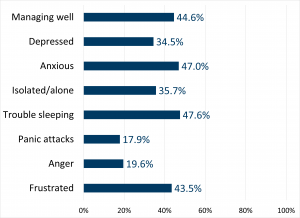
#21 | From a mental health perspective, please indicate your state of wellness since the onset of the pandemic (choose all that apply).
Our respondents also indicated experiencing other negative effects such as being tired, increased headaches, irritability, overwhelmed, burnout and frustration. 19.4% had challenges managing childcare (school closures, daycare, remote learning) and worried about parents’ well-being and needs.
13.9% of members have not taken any vacation days since March 2020. Reasons for this included that the workload is too high. 33.3% (as of early January) still have more than 11 vacation days available. 21.8% anticipate concerns taking vacation days above the carry over limit by March 31, 2021.
AESES encourages members to take their allocated vacation days from work to recharge and forget about work for a while. Even if you only unplug from the computer and spend time with your family, pets or binge a television series.
Conclusion
With over seventy-eight percent of AESES-UW members working remotely, 60.0% would want this to continue after the pandemic, and 29.4% said no. 24.1% of respondents said that they were considered essential services from supervisors.
Most members stated they wanted a combination of remote and on-campus work options once the UW returns to normal operations. A few benefits mentioned were the ability to work through sick days, terrible road/weather conditions, at home with a sick child, better mental health and work/life balance, and free up much-needed campus office space.
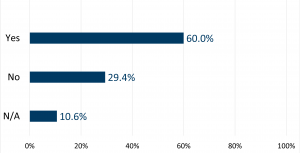
#36 | If you’ve been working remotely since the start of the pandemic, would you prefer to continue working from home when the University resumes normal operations?
Members also noted they feel a lack of communication from supervisors and the UW and stated how they felt there was no appreciation or recognition from the UW for the work done to support students and faculty during the pandemic.
As the survey was completely anonymous, some members may want to further discuss their workload or other workplace concerns with our Business Office based on the answers provided. Please call 204-949-5200 or aeses@aeses.ca if you feel this pertains to you. We are here to help.
